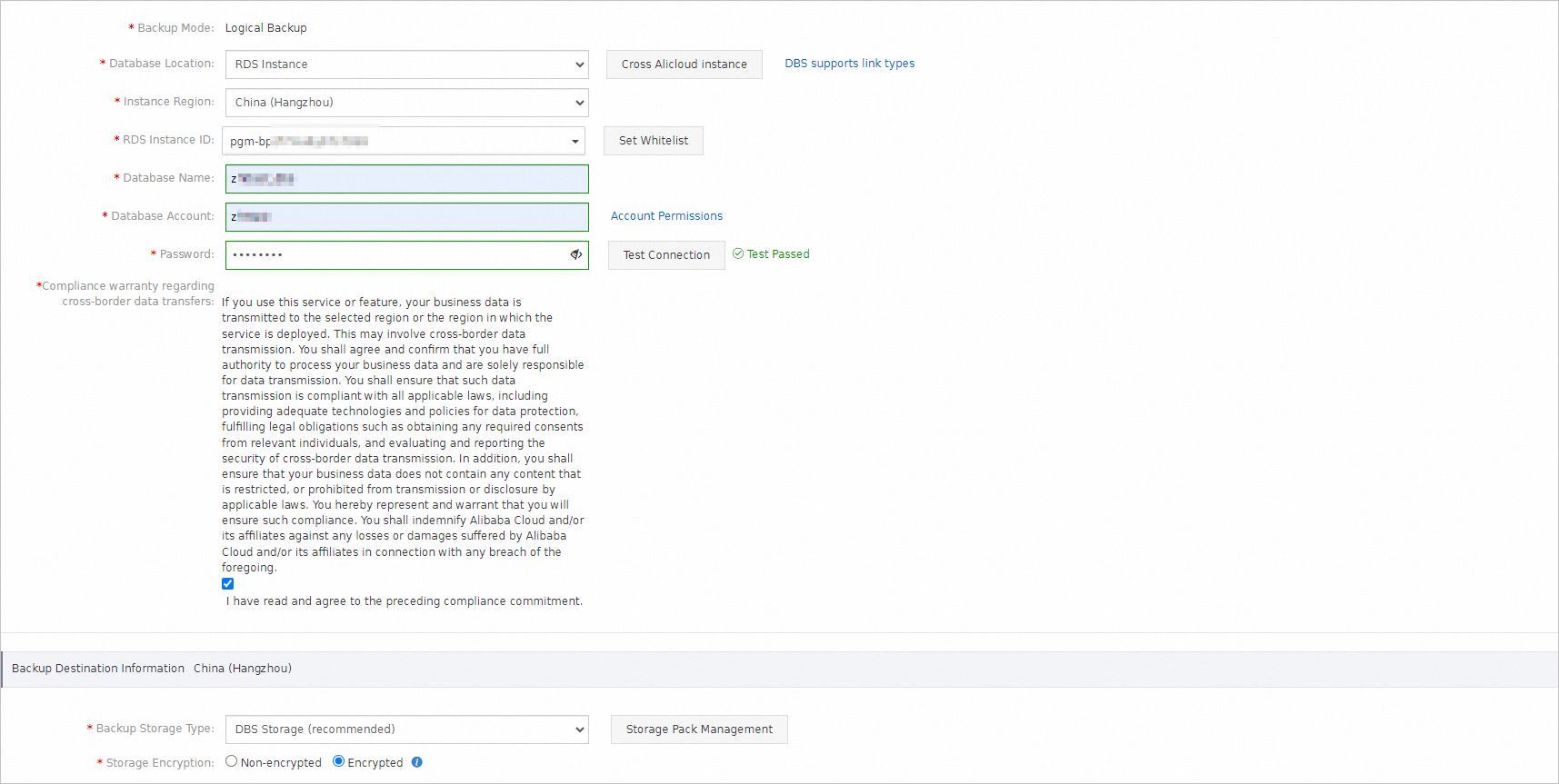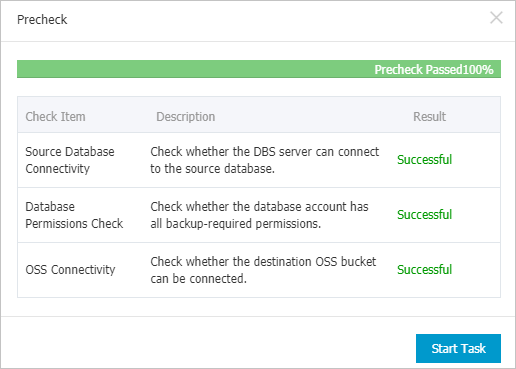Database Backup (DBS) provides features such as single-table restoration, geo-redundancy, and long-term archiving for PostgreSQL databases. This topic describes how to back up a database in an ApsaraDB RDS for PostgreSQL instance, a database in a PolarDB for PostgreSQL cluster, or a database whose data source type is PostgreSQL by using logical backup.
Usage notes
Each DBS backup schedule can be used to back up only one PostgreSQL database by using logical backup. The PostgreSQL database can be a database in an ApsaraDB RDS for PostgreSQL instance, a database in a PolarDB for PostgreSQL cluster, or a database whose data source type is PostgreSQL. If you want to back up multiple PostgreSQL databases, you must purchase a DBS backup schedule for each database.
DBS does not support incremental backup for PostgreSQL databases.
Create a backup schedule
For more information, see Purchase a backup schedule.
When you purchase a backup schedule, set the Data Source Type parameter to PostgreSQL and the Backup Method parameter to Logical Backup.
For information about the PostgreSQL versions that are supported by DBS logical backup, see Database engines and features.
Configure a backup schedule
Log on to the Database Backup (DBS) console.
In the left-side navigation pane, click Backup Schedules. In the top navigation bar, select a region.
On the Backup Schedules page, find the ID of the backup schedule that you want to configure and click Configure Backup Schedule in the Actions column.

In the Configure Backup Source and Destination step of the Configure Backup Schedule wizard, configure the backup source and destination, and click Next in the lower-right corner of the page.

Table 1. Database parameters Section
Parameter
Description
N/A
Schedule Name
The name of the backup schedule. DBS automatically generates a backup schedule name. We recommend that you set a descriptive name that is easy to identify. Backup schedule names do not need to be unique.
Backup Source Information
Backup Mode
The method that is used to back up data. The default value of this parameter is the backup method that you selected when you purchased the backup schedule. In this example, Logical Backup is selected.
Database Location
The location of the database that you want to back up. Valid values:
RDS Instance: backs up a database in an ApsaraDB RDS for PostgreSQL instance. You must also configure the RDS Instance ID parameter.
PolarDB: backs up a database in a PolarDB for PostgreSQL cluster. You must also configure the POLARDB Instance ID parameter.
ECS-Hosted Database: backs up a database hosted on an Elastic Compute Service (ECS) instance. You must also configure the ECS Instance ID and Port Number parameters.
User-Created Database with Public IP Address <IP Address:Port Number>: backs up a self-managed database by using the public IP address of the database. You must also configure the Address and Port Number parameters.
Express Connect DB/VPN Gateway/Intelligent Gateway: backs up a self-managed database by using a virtual private cloud (VPC). Before you configure the Peer VPC parameter, you must configure a VPC for the database. For more information, see topics such as Back up a self-managed database in a data center connected to Alibaba Cloud over Express Connect to OSS or DBS and Back up a user-created database in an on-premises data center connected to Alibaba Cloud through VPN Gateway or Smart Access Gateway to OSS or DBS.
No public network IP: Port's self-built database (accessed through the database gateway): backs up a self-managed database by using a database gateway. Before you configure the Gateway instance ID parameter, you must configure a database gateway for the database. For more information about the configurations, see Use Database Gateway to back up on-premises databases or private databases on a third-party cloud to Alibaba Cloud.
Instance Region
The region in which the source database resides.
This parameter is displayed only if you set the Database Location parameter to RDS Instance, PolarDB, ECS-Hosted Database, or No public network IP: Port's self-built database (accessed through the database gateway).
Database Type
The type of the database that you want to back up. Default value: PostgreSQL or PolarDB for PostgreSQL.
Database Name
The name of the database that you want to back up.
ImportantEach DBS backup schedule can be used to back up only one PostgreSQL database by using logical backup. If you want to back up multiple PostgreSQL databases, you must purchase a DBS backup schedule for each database.
Database Account
The username of the account that is used to connect to the source database. The account must have specific permissions to back up the database. For more information, see Account permissions.
Note For ApsaraDB RDS databases, read-only permissions are required for backup, and read and write permissions are required for backup and restoration.Password
The password of the account that is used to connect to the database that you want to back up.
After you enter the username and password of the database account, click Test Connection next to the password to check whether the information of the database that you want to back up is valid. If the specified parameters are valid, the Test Passed message is displayed. If the Test Failed message is displayed, click Check next to Test Failed. Modify the information about the instance that you want to back up based on the check results.
Compliance warranty regarding cross-border data transfers
Read the statement of compliance and select I have read and agree to the preceding compliance commitment.
Backup Destination Information
Backup Storage Type
The type of storage that is used to store the backup data. Valid values:
- DBS Storage (recommended): Backup data is stored in DBS without requiring you to create storage space. You are charged based on the volume of your data that is stored in DBS. For more information about the billing method, see Storage fees.
To reduce storage costs, we recommend that you use subscription storage plans. For more information, see Use storage plans.
- OSS For User: You must create a bucket in the Object Storage Service (OSS) console in advance. For more information, see Create buckets.
Note In this example, DBS Storage (recommended) is selected. If you select OSS For User, you must configure the OSS Bucket Name parameter, and only the Standard storage class is supported.Storage Encryption
The method that is used to encrypt the stored data. Valid values:
- Encrypted: recommended. DBS uses AES-256 to encrypt the stored data. AES-256 is one of the advanced encryption standard ciphers.
The server-side encryption feature is used in OSS. When you upload an object to OSS, OSS encrypts and stores the object. When you download the encrypted object from OSS, OSS decrypts the object and returns the decrypted object to you. For more information, see Server-side encryption.
- Non-encrypted: The backup data is not encrypted.
In the Edit Backup Objects step, find the database or table that you want to back up and add it to the Selected section. Then, click Next.
NoteIf you selected Logical Backup when you purchased a backup schedule, DBS allows you to use the backup schedule to back up the entire database or a single table in the database during full backups. You can click Select All in the lower-left corner of the page to back up the entire database. For more information about the granularity of logical backup, see Database engines and features.
If you selected Physical Backup when you purchased a backup schedule, you can use the backup schedule only to back up the entire database.
In the Configure Backup Time step, configure the parameters that are described in the following table and click Next in the lower-right corner of the page.
Parameter
Description
Full-scale Backup Frequency
The frequency of the backup schedule. Select Periodic Backup or Single Backup as needed.
Note If you set this parameter to Periodic Backup, you must set the Full Data Backup Recurrence and Start At parameters.Full Data Backup Recurrence
The days of the week on which DBS runs the backup schedule. You can select one or more days of a week. Select at least one day of the week.
Full Backup Started At
The start time of the backup. We recommend that you set a point in time within off-peak hours. Example: 01:00.
Note If a previous full data backup is not finished at the start time of the next backup, DBS skips the next backup.Incremental Backup
DBS does not support incremental backup for PostgreSQL databases.
Maximum Concurrent Threads for Full Data Backup
The maximum number of concurrent threads available for a full backup. You can set this parameter to adjust the backup speed. For example, reduce the number of backup threads to minimize impacts on the database.
The maximum number of actual concurrent threads varies based on backup schedule specifications. For more information, see How do I change the maximum backup speed?
In the Edit Lifecycle step, configure the lifecycle for a full backup set in the Configure Full Data Backup Lifecycle section.
- After the preceding configurations are complete, click Precheck in the lower-right corner of the page.
If the Precheck Passed message appears, click Start Task.
 Note When the state of the backup schedule changes to Running, the backup schedule takes effect.
Note When the state of the backup schedule changes to Running, the backup schedule takes effect.
What to do next
After a backup is complete, you can view the backup schedule or restore the database. For more information, see View a backup schedule and Restore an ApsaraDB RDS for PostgreSQL database.